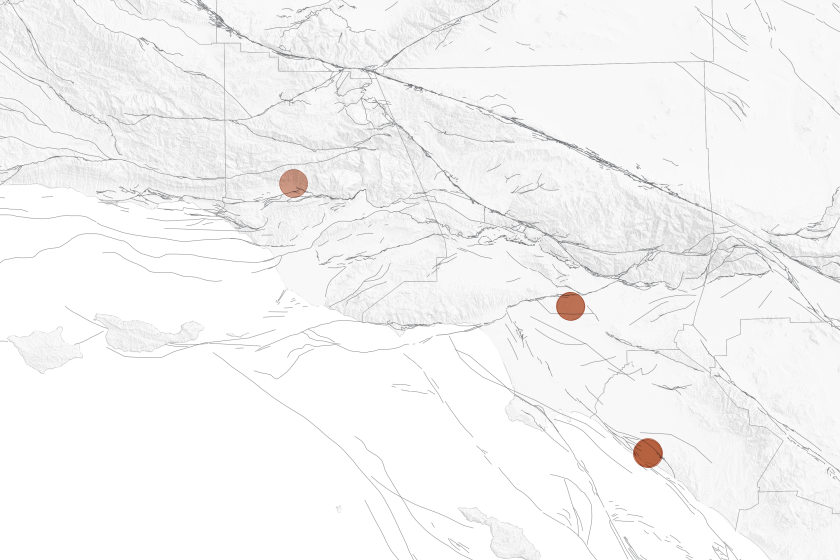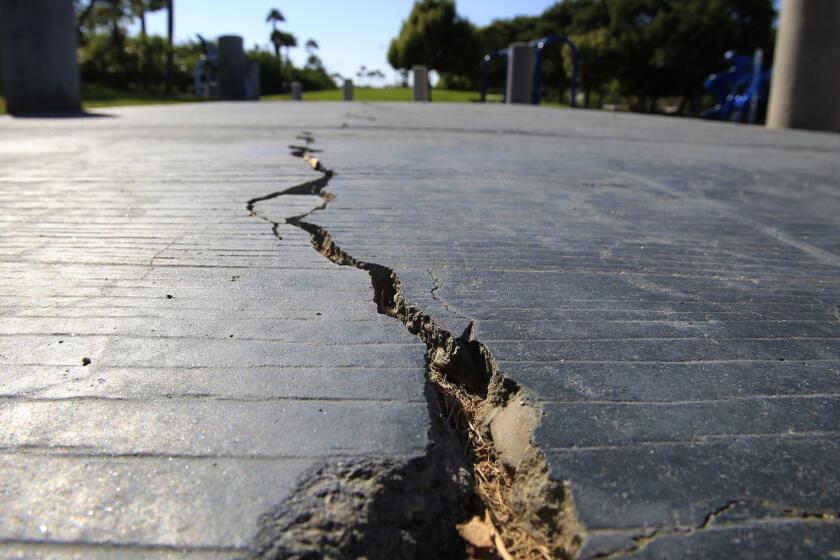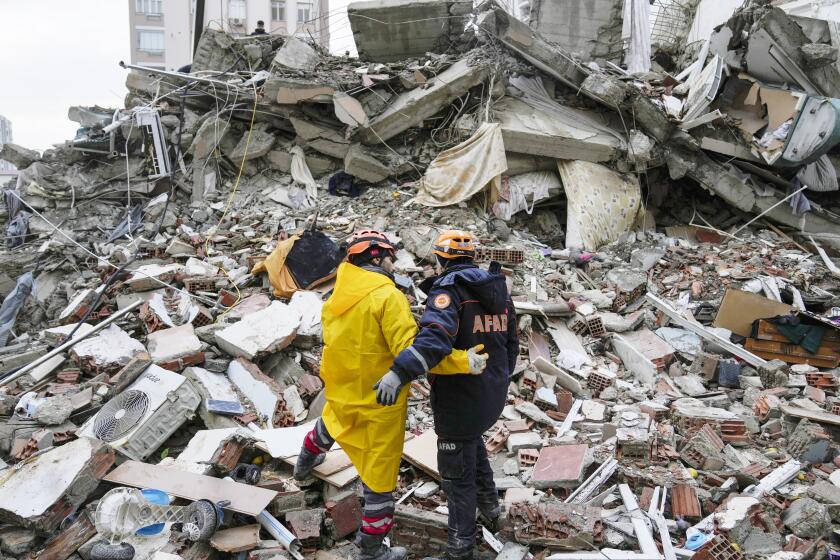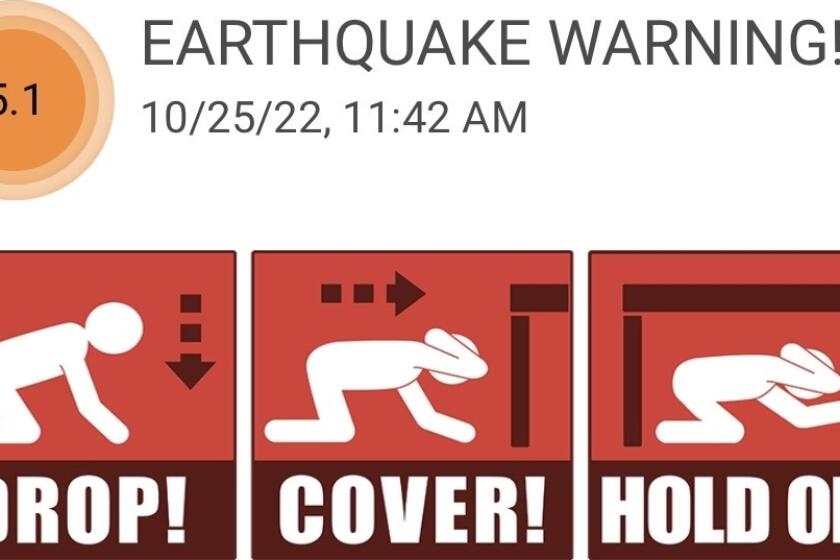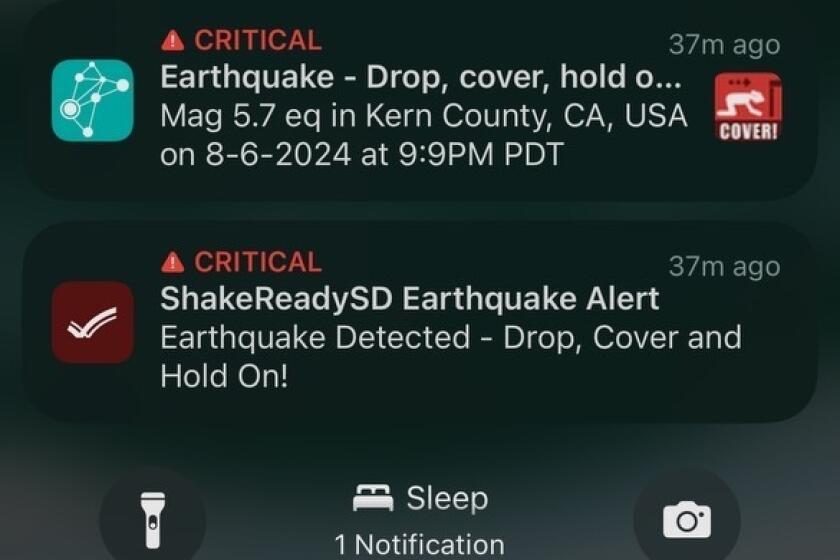4.4 earthquake was centered on notorious L.A. fault system
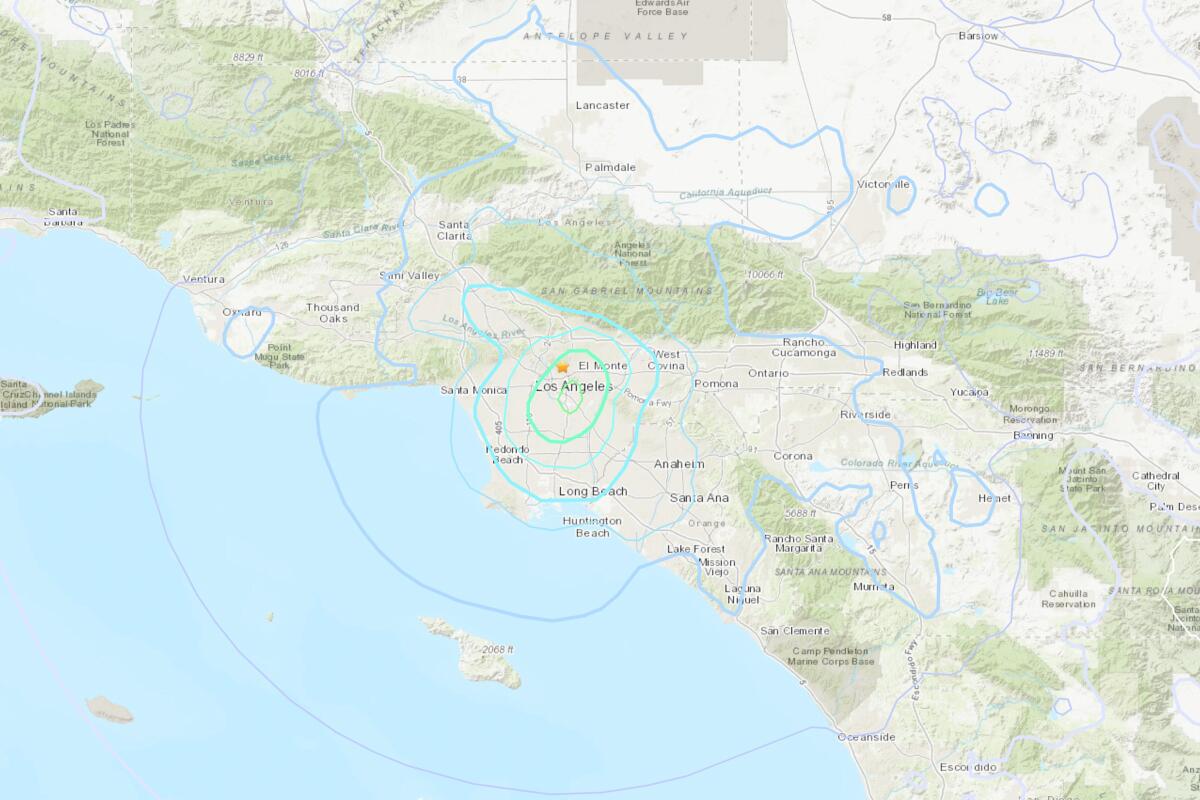
- Share via
The magnitude 4.4 earthquake that rattled Los Angeles on Monday was centered within one of the region’s most potentially destructive fault systems, one capable of producing a magnitude 7.5 earthquake under the heart of the region.
Seismologist Lucy Jones, a Caltech research associate, said the earthquake, centered in the Eastside neighborhood of El Sereno, occurred on the Puente Hills thrust fault system. It’s the same overall fault network that produced the 1987 Whittier Narrows magnitude 5.9 earthquake — which killed eight people and caused some $358 million in damage.
A magnitude 7.5 quake in the Puente Hills thrust fault system — which runs under highly populated areas of L.A. and Orange counties — could kill 3,000 to 18,000 people, according to the U.S. Geological Survey and Southern California Earthquake Center. The economic loss could be up to $252 billion, which could be the costliest disaster in U.S. history.
That’s worse than the hypothetical death toll of 1,800 people from a plausible magnitude 7.8 earthquake that begins on the southern San Andreas fault near the Mexican border and unzips all the way to the mountains of L.A. County.
“It’s a reminder that this is actually our most dangerous fault,” Jones said.
A big earthquake on the San Andreas fault comes every century or so, and one within the Puente Hills thrust fault system comes every few thousand years. But if a magnitude 7.5 earthquake in the Puente Hills thrust fault system comes in our lifetime, it would be far worse for the L.A. area than a big one on the San Andreas.
The Puente Hills thrust is a complex fault system with many intersecting strands, Jones said. It’s possible that the fault strand that ruptured in Monday’s quake itself is technically small and unnamed, Jones said. Whatever it is, Monday’s quake is associated with the greater Puente Hills thrust fault system.
Monday’s earthquake, centered about 1,100 feet southwest of the intersection of Huntington Drive and Eastern Avenue, occurred in the same general area of a pair of earthquakes in early June — a magnitude 3.4 on June 2 and a magnitude 2.8 on June 4, also associated with the Puente Hills thrust fault system. There was also a magnitude 2.9 earthquake in the same area on June 24.
Having half a dozen earthquakes with a magnitude 2.5 or greater strike in a single week is not a common occurrence in Southern California.
“All of these earthquakes are closely spaced in three dimensions, just beneath the main Puente Hills thrust [fault] plane,” USC earth sciences professor James Dolan said. “They’re all associated with the same cluster of small events.
“But the key thing is, they are very small events. These are very small earthquakes that don’t necessarily mean anything in terms of potentially being the harbinger of a future large magnitude earthquake on the Puente Hills thrust,” Dolan said.
Still, people should heed the lessons from this small quake, Dolan said, and take action to prepare for future ones, such as buying extra water for their home and workplace, and securing spaces like fastening bookshelves to walls. “If it inspires even a few people to do that ... that’s a good thing for L.A.,” Dolan said.
“People really need to be ready for a very, very large earthquake, or earthquakes, in L.A.’s future. It’s going to happen. We don’t know when. We don’t know exactly which fault is going to generate those earthquakes, but they are going to happen,” Dolan said.
Monday’s earthquake is also a reminder of how, while some large cities in the region, such as L.A., have taken action to order earthquake retrofits of certain types of buildings, most others have not.
One vulnerable type of building that has received considerable attention from some cities are apartment buildings with flimsy first stories, held up by skinny poles atop carports that can collapse when shaken. While cities such as Los Angeles, Torrance, Pasadena, Santa Monica, Culver City, West Hollywood and Beverly Hills have ordered such buildings to be retrofitted, most others in the region have not, including areas in the San Gabriel Valley and southeast L.A. County shaken up by Monday’s temblor.
“This is something that not only kills people, as we saw in ’94, but it also leaves people homeless,” Jones said, referring to the collapse of the Northridge Meadows apartment complex during a magnitude 6.7 earthquake three decades ago. “I would strongly encourage anybody ... that has an influence on this to look at getting more of those buildings retrofitted, because we can’t afford to lose that housing when a bigger earthquake comes through.”
Another building at high risk are “non-ductile” concrete buildings, which, as recent earthquakes in Mexico, Turkey and Syria have shown, can cause large numbers of deaths if the flaws are not resolved.
The San Andreas fault is capable of magnitude 7.8 earthquakes. Two have occurred twice in recent times: the 1906 San Francisco earthquake and one in 1857 in Southern California.
The Puente Hills thrust fault system is especially worrisome because of what’s on top of it — downtown Los Angeles, which has many old and unretrofitted buildings, as well as broad swaths of southeast L.A. County, the San Gabriel Valley and northern Orange County.
Monday’s earthquake was notable for stronger shaking occurring southwest of the epicenter. One explanation for that is those locations happen to sit on thicker piles of sediments — sand, gravel and soils — and as a result, it’s going to shake more there than for people on top of bedrock, Dolan said.
That would explain why many felt scary shaking on top of the Los Angeles Basin, a 6-mile-deep, bathtub-shaped hole in the underlying bedrock filled with weak sand and gravel eroded from the mountains and forming the flat land where millions of people live. The area stretches from Beverly Hills through southeast L.A. County and into northern Orange County.
Mike Martinez can tell you what it feels like to be at the epicenter of a moderate earthquake. Martinez is a painter at Frank’s Auto Body & Paint at Huntington Drive and Collis Avenue, which is exactly where the underground fault ruptured.
Martinez remember a loud, sharp blow and then a few residual vibrations. Everything was over in a few seconds.
“Some other times, it starts low, then increases,” Martinez said. “This hit like a truck.”
What was going through his mind?
“The Big One is coming up,” Martinez said.
The northwest corner of that intersection is occupied by an auto plaza with three shops. Next door, Eduard Balasian, the owner of AA Auto & Muffler, recalled that all the employees from all the shops ran outside into the parking lot.
Products and supplies fell off shelves, but that was the worst of it. Nothing spilled or broke open.
“We are lucky that a car wasn’t on a lift,” he said. The initial jolt, he said, was violent enough to have knocked a car off the service lift, imperiling anyone working directly below. “We are lucky.”
The earthquake caused a water pipe to burst at Pasadena City Hall, where water leaked for about an hour before it was turned off, city spokesperson Lisa Derderian said.
It also caused an issue with elevators at the building, and an employee was stuck in one of the cars for about 20 minutes before being let out. The elevators will be closed until they can be repaired.
The fire department is conducting surveys around the city, and an engineer is being sent to the Rose Bowl as a precaution to assess for any issues.
Monday’s magnitude 4.4 earthquake — centered near Highland Park — came with an early warning from California’s quake alert system.
Darlene Hampton, a senior office assistant in the Pasadena city manager’s office, was helping a resident at City Hall when the shaking started.
“She was having a little bad day,” Hampton said about the resident. “I was able to calm her down, and we just said, ‘Everything’s going to work out, right?’ And then the earthquake hit. But we were doing a little prayer too.”
All employees and customers were able to leave the building safely, Hampton said, and wait outside until the fire department arrived.
“The funny thing is, as she’s going out the door, I said, ‘You see how quickly God works?’ ”

The shaking brought a short jolt of up-and-down motion that knocked shampoo bottles off the shelf at the Target in Alhambra, as well as the “shredded cheese” sign off a refrigerated aisle, and shoppers started calling loved ones to see whether they were OK.
In Highland Park, windows rattled and dogs barked, and coffee spilled off a table. Elsewhere in Alhambra, photos were knocked off the shelf, drawers opened and shoes were thrown from a rack.
The temblor struck at 12:20 p.m. The preliminary epicenter was in El Sereno, about 1,000 feet southwest of Huntington Drive and Collis Avenue.
The strongest shaking was considered “moderate,” or Level 5 on the Modified Mercalli Intensity Scale, where the shaking was felt by nearly everyone and capable of overturning unstable objects. Moderate shaking was experienced in downtown Los Angeles, South Pasadena, Highland Park, Mount Washington, Alhambra, Monterey Park, Boyle Heights, East L.A., South L.A., Huntington Park, Bell, Maywood, Bell Gardens, Cudahy and South Gate, according to the USGS.
People across the region felt shaking strong enough to knock items from shelves, including a bottle of bay leaves in Koreatown. The seventh floor of The Times’ headquarters in El Segundo, near Los Angeles International Airport, swayed as lights flickered and televisions that hang on walls swayed. In the Los Feliz-East Hollywood area, car alarms sounded, candles were knocked off tables and people exclaimed, “That was scary!” Windows at businesses in Los Feliz shook.
In Silver Lake, a loud, sharp jolt lasted five to 10 seconds, shaking the exhaust hood in a kitchen. Windows rattled and the walls shook at one home in Atwater Village.
Earthquakes are a way of life if you live in Los Angeles. But what about when you never feel them — even as your Shake Alert is blaring and your friends are buzzing about the temblor?
In Arcadia, people felt both a shaking and rolling motion, lasting about 20 seconds or so — like a nearby train rolling through. One person in South Pasadena felt a very sharp, loud jolt, sending her under the table, but nothing broke or fell. A person in Mid-City felt a sizable jolt on the ground floor.
Dozens of Inglewood community members and teachers crowded outside Morningside High School, just a mile south of SoFi Stadium, to eat lunch after an event attended by Jimmy Iovine, co-founder of Interscope Records, when the ground rumbled for a full second.
“That a quake?” a teacher asked a colleague.
At Fatty Mart convenience store in Mar Vista, people in the seating area simply stared at one another when the shaking arrived. Two continued munching on their food, while another kept working at his computer.
“Is this an earthquake?” someone said five seconds into the shaking, which lasted for 10 or 15 seconds longer.
Having half a dozen earthquakes with a magnitude 2.5 or greater strike in a single week is not a common occurrence in Southern California.
Many Southern California residents received alerts on their phones warning the quake was coming, another win for the region’s earthquake early warning system. Some got the warning just after the jolt hit, as they were quite close to the epicenter.
There were no reports of damage, the fire departments for the city and county of Los Angeles said. The South Pasadena Police Department has not received any calls for service, other than multiple reports of home alarms being set off by the earthquake.
Anthony Montiel, facility director with the Lincoln Heights Senior Center, said there were no reports of any injuries or emergency calls for assistance.
He said for the most part, everyone kept calm — save for himself.
“I’m more scared than anyone else, with them being seniors and having more life experience,” Montiel said with a laugh.
“It felt like a truck hit the building. It was like a strong jolt that lasted a few seconds, and nothing like a rolling earthquake,” he added.
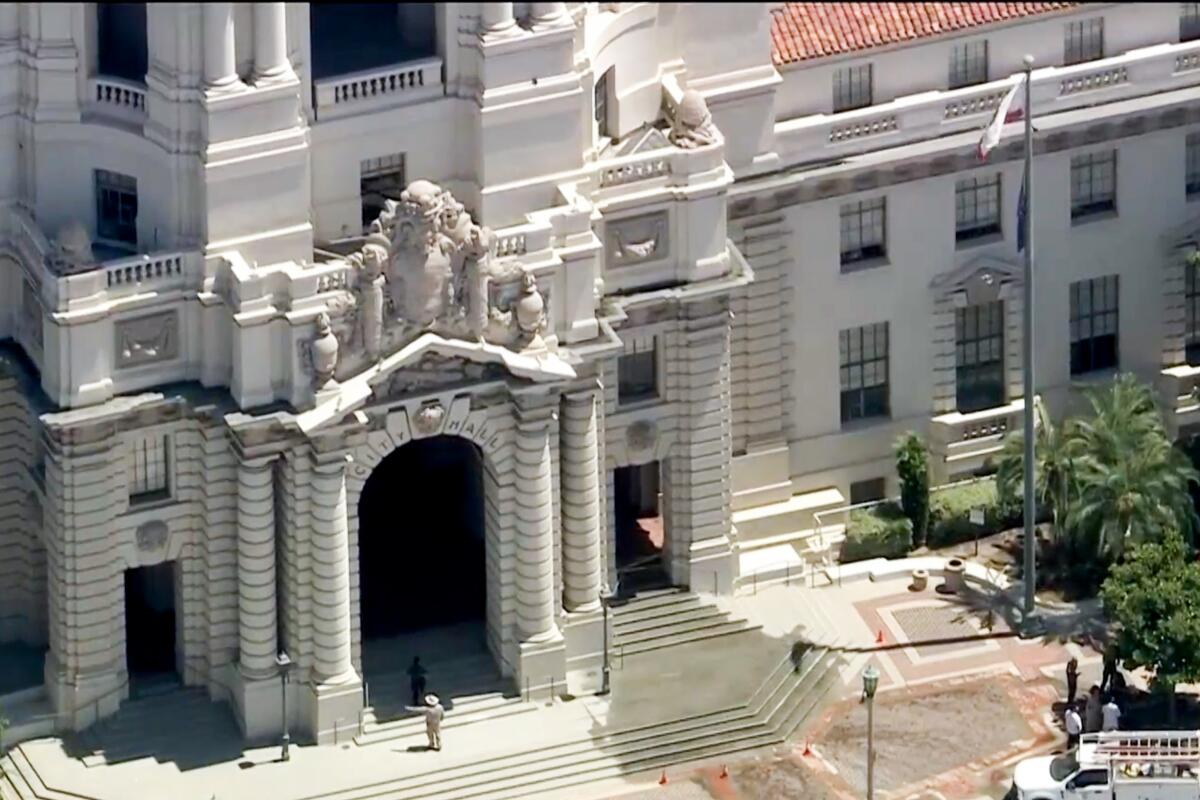
When a quake struck Bakersfield last week, millions got the alert.
More than 5.4 million early-warning phone alerts went out Tuesday for the magnitude 5.2 quake that struck near Bakersfield in Kern County.
According to the U.S. Geological Survey, Monday’s temblor was felt across the L.A. basin and as far away as San Diego and Ventura.
Those who have iPhones can get earthquake early warnings by downloading the free MyShake app, developed by UC Berkeley and provided in partnership with the California Governor’s Office of Emergency Services, which alerts users in California, Oregon and Washington. San Diego County also offers the free SD Emergency app, which includes the ShakeReadySD earthquake early-warning tool.
People who don’t have smartphones or haven’t installed early-warning apps can still get quake alerts on their cellphones — but only for those in which a higher magnitude or higher level of shaking is projected at their location. Those alerts are sent through the Wireless Emergency Alert system, similar to Amber Alerts.
The shaking was light enough for some to make jokes.
In a downtown L.A. courtroom, a fire alarm went off multiple times a couple of hours after the shaking.
“It could be a delayed reaction to the earthquake?” said Judge Sam Ohta from the ninth floor of the Clara Shortridge Foltz Criminal Justice Center, which shook for several seconds around lunchtime. “1971 building.”
“The county’s early warning system,” someone joked.
Times staff writers Ashley Ahn, Hector Becerra, Andrew J. Campa, Stephanie Chavez, Cindy Chang, Karen Kaplan, Defne Karabatur, Maria L. La Ganga, Sandra McDonald, Brittny Mejia, Emily Alpert Reyes, Joseph Serna, Alene Tchekmedyian, and Rachel Uranga contributed to this report.
More to Read
Sign up for Essential California
The most important California stories and recommendations in your inbox every morning.
You may occasionally receive promotional content from the Los Angeles Times.
